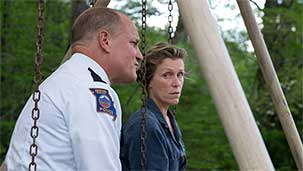Three Billboards Outside Ebbing, Missouri is the sort of film I’ve come to have mixed feelings about. Multi-tiered casts (from pretty big names to the hey, it’s that guy types) playing characters pitched in both major and minor keys, fighting for camera time and poignant moments in the middle of a convoluted plot. Get Shorty is a good example of this kind of film, Smokin’ Aces is a particularly egregious ones.
Too often with films like these, they become competitions. You can see actors twist and contort trying to create a memorable moment in the midst of a lot of very deliberate capital-A acting. All of this acting occurs in the midst of a plot so filled with serendipity that it would be thrown head first out of a casino. It can get tiresome pretty quick.
You have a lot of experience with this sort of thing, having been the go-to casting director for most of the Marvel films over the last five years, specifically for those with a cast of thousands: Guardians of The Galaxy (I and II), Thor Ragnorok, Captain America: The Winter Soldier, and on and on. The difference here is Three Billboards Outside Ebbing, Missouri was made on the catering budget of those films, and requires a much finer touch. In the Marvel films, if one of the characters falls a little flat, or plays a little too big, there is a lot of CG smoke and thunder to fall back on. Huge blockbusters aren’t necessarily counting on the weight of performances to achieve their ends. But with a film like Three Billboards Outside Ebbing, Missouri, there is nothing but the actors and how well, or poorly, they execute their craft.
Centred around an unsolved murder in a backwoods town, and the conflict that arises from that circumstance, Three Billboards Outside Ebbing, Missouri (even the title is a touch too deliberate) is a snake with maybe one too many heads. Plot lines and characters double back and cross over one another in a way that feels calculated and overt. As a result this is a film whose success depends wholly on the chemistry between the various players. One sour note, one person out of sync, and the whole thing would fall apart. This is largely because the plot is wearing its skeleton outside its skin, so much so that if you weren’t completely involved in the characters onscreen you would spend most of your time counting the bones.
Despite all of that anatomy on display, Three Billboards Outside Ebbing, Missouri works. A lot of that falls to you and the choices you helped make. Not just in the main cast but with the bit parts. Each person manages to make their screen time memorable while maintaining pitch with the 842 piece orchestra. That doesn’t mean Frances McDormand isn’t dominant, because she is. But what it does mean is that the film is as good as it is because everyone swirling around her—most notably Woody Harrelson and Sam Rockwell—create moments that feel genuine and human, as well as hilarious, menacing and poignant. Often in quick succession.
The bit players: John Hawkes, Clark Peters, Peter Dinklage and many, many others, fill in the spaces that Ebbing, Missouri needs filled in order to be something other than a two dimensional backdrop. And they do it with a quiet efficiency that doesn’t call attention to itself. It’s fun to watch actors create lived-in characters with so little screen time. It helps to flesh out a film in a way that makes it memorable for the right reasons.
Any film that can gather this kind of talent and isn’t written by a twelve year old is something I would probably make time for. But in the end, and sometimes despite itself, Three Billboards Outside Ebbing, Missouri is powerful and affecting. It lingers in your head long after you’ve left the theatre, and is well worth revisiting as a master class in character work.
Sincerely,

Tim







